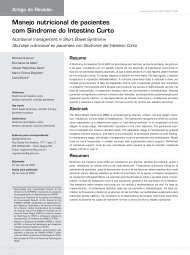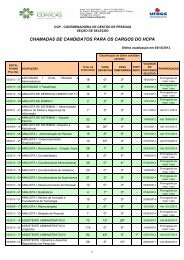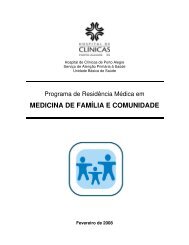Anais da 27º Semana CientÃfica - Hospital de ClÃnicas de Porto Alegre
Anais da 27º Semana CientÃfica - Hospital de ClÃnicas de Porto Alegre
Anais da 27º Semana CientÃfica - Hospital de ClÃnicas de Porto Alegre
You also want an ePaper? Increase the reach of your titles
YUMPU automatically turns print PDFs into web optimized ePapers that Google loves.
122<br />
Revista HCPA 2007; 27 (Supl.1)<br />
would be 40.9%, 33.2% and 45.6%, respectively. The prevalence also varied by age (52% in subjects 16-40y and 43.2% in<br />
subjects 40-65y) (P=0.001). Conclusions: This first population-based nation wi<strong>de</strong> survey conducted in South America estimates<br />
that the prevalence of NID is higher than in studies conducted in Western <strong>de</strong>veloped countries. The sex distribution is similar to<br />
previous epi<strong>de</strong>miological studies from low-prevalence H. pylori countries. Whether this unexpected high prevalence of noninvestigated<br />
dyspepsia in Brazil is explained by the presence of this bacteria, remains to be further explored by future studies.<br />
BRAZILIAN PREVALENCE OF IRRITABLE BOWEL SYNDROME: A POPULATION-BASED STUDY<br />
GUILHERME BECKER SANDER; CARLOS FERNANDO MAGALHÃES FRANCESCONI, LUIZ EDMUNDO<br />
MAZZOLENI, MARIA HELENA ITAQUI LOPES, OTÁVIO BERWANGER, JULIO MADI<br />
Introduction: there is no population-based surveys conducted in South America to estimate the prevalence and the sex distribution<br />
of IBS.Objective: To estimate the prevalence of irritable bowel syndrome (IBS) on Brazilian population. Methods: Populationbased<br />
cross-sectional survey sampled by two steps. First: phone numbers were randomly chosen in houses that were sampled<br />
through a simple probabilistic method among 223 cities, encompassing 83.5 million inhabitants, sampling approximately 51% of<br />
the Brazilian population. In the second step, phone calls were done and the atten<strong>da</strong>nt person asked about all housemates with ages<br />
between 16 and 65 years (y). Among them, a second simple probabilistic sampling was done to choose the person to be<br />
interviewed. Interviews were conducted by trained researchers using a stan<strong>da</strong>rdized questionnaire. A modification of the ROME II<br />
modulate questionnaire was used to <strong>de</strong>fine IBS for the purpose of this study. Results: 1510 persons were interviewed, with a mean<br />
age of 37.6y (SD13.8y). The prevalence of IBS in the entire sample was 16.1 %. In males, the prevalence was 10.1%, and in<br />
females 19.9%. The prevalence do not varied by age (17.2% in subjects 16-40y and 14.9% in subjects 41-65y, P=0.23).<br />
Conclusions: This first population-based survey conducted in South America estimates the prevalence and the sex distribution of<br />
IBS in Brazil is the same as seen in the Western <strong>de</strong>veloped countries. These results suggest that infectious diarrhea (ID), a very<br />
high inci<strong>de</strong>nce condition in our country, could not be a trigger factor for IBS, as suggested by some authors, mainly from<br />
<strong>de</strong>veloped, low inci<strong>de</strong>nce countries for ID. This is an attractive hypothesis that <strong>de</strong>serves be explored by further studies.<br />
PREVALÊNCIA DA INFECÇÃO PELO HELICOBACTER PYLORI EM PACIENTES DISPÉPTICOS FUNCIONAIS DE<br />
ACORDO COM A ETNIA<br />
RAFAEL DO AMARAL CRISTOVAM; ANE PAULA CANEVESE, ANDRÉ C WORTMANN, GUILHERME B SANDER,<br />
CARLOS F FRANCESCONI, ALEXANDRO THEIL, ANALIA MALDONADO, GISELE S MORAES, FELIPE MAZZOLENI,<br />
ALINE GAMARRATI, PÂMELA S REISSWITZ, LAURA DE BONA, HUANDER ANDREOLLA, ALEXANDRE ARAUJO,<br />
LUIZ EDMUNDO MAZZOLENI. HOSPITAL DE CLÍNICAS DE PORTO ALEGRE.<br />
Introdução: Em países <strong>de</strong>senvolvidos, tem sido observado variações <strong>de</strong> prevalências <strong>de</strong> infecção pelo Helicobacter pylori em<br />
diferentes etnias. Objetivo: avaliar se a mesma variação é observa<strong>da</strong> em nosso meio. Amostra: Pacientes com mais <strong>de</strong> 18 anos,<br />
com diagnóstico <strong>de</strong> dispepsia, segundo os critérios <strong>de</strong> Roma III, que aten<strong>de</strong>ram espontaneamente convite para participação no<br />
estudo publicado em mídia leiga. Todos pacientes foram submetidos a esofagoduo<strong>de</strong>noscopia e foram excluídos pacientes com<br />
alterações anatômicas ao exame, exceto gastrites, duo<strong>de</strong>nites e hérnias <strong>de</strong> hiato. Método: Em umm estudo transversal, pacientes<br />
maiores <strong>de</strong> 18 anos com dispepsia segundo os critérios <strong>de</strong> Roma III respon<strong>de</strong>ram a questionário dirigido por entrevistador, após<br />
assinatura <strong>de</strong> consentimento livre e esclarecido. Para fins <strong>de</strong>ste estudo, a etnia do paciente foi classifica<strong>da</strong> pelos investigadores em<br />
branco e não-branco. A coleta <strong>de</strong>stes <strong>da</strong>dos foi realiza<strong>da</strong> <strong>de</strong>ntro do projeto GGPG 05-422, aprovado no Comitê <strong>de</strong> Ética em<br />
Pesquisa do <strong>Hospital</strong> <strong>de</strong> Clínicas <strong>de</strong> <strong>Porto</strong> <strong>Alegre</strong>. Resultados: Foram avaliados 274 pacientes. Destes, 217 pacientes foram<br />
classificados como brancos (79,2%) e os <strong>de</strong>mais como não brancos. A prevalência <strong>de</strong> infecção em pacientes classificados como<br />
brancos foi <strong>de</strong> 66.8% e a prevalência nos não-brancos foi <strong>de</strong> 70,2%. A razão <strong>de</strong> prevalências foi 0,95 (IC95% 0,78-1,16).<br />
Conclusão: As diferenças étnicas na nossa população <strong>de</strong> estudo não influenciaram na prevalência <strong>de</strong> infecção pelo Helicobacter<br />
pylori, diferentemente do <strong>de</strong>monstrado em algumas regiões <strong>de</strong> países <strong>de</strong>senvolvidos.<br />
PREVALÊNCIA DE METAPLASIA INTESTINAL EM DISPÉPTICOS FUNCIONAIS COM E SEM INFECÇÃO PELO<br />
HELICOBACTER PYLORI<br />
GISELE SILVA DE MORAES; LUIZ EDMUNDO MAZZOLENI, DIEGO UCHOA, MARIA ISABEL EDELWEISS, LUISE<br />
MEURER, RAFAEL DO AMARAL CRISTOVAM, GUILHERME BECKER SANDER, CARLOS FERNANDO<br />
FRANCESCONI, NATAN KATZ, CYNTHIA GOULART MOLINA, ALEXANDRO THEIL, OSCAR AUGUSTO BIRKHAN,<br />
BIANCA SPINDER, BIANCA HOCEVAR, PEDRO PROENÇA GUERRIERI<br />
Introdução: A metaplasia intestinal é consi<strong>de</strong>ra<strong>da</strong> um importante precursor <strong>de</strong> a<strong>de</strong>nocarcinoma gástrico. Em países orientais, é<br />
<strong>de</strong>monstrado que o Helicobacter pylori (H.pylori) é fator <strong>de</strong> risco para o <strong>de</strong>senvolvimento <strong>de</strong> metaplasia intestinal, mas esta<br />
associação tem sido pouco estu<strong>da</strong><strong>da</strong> em países oci<strong>de</strong>ntais. Métodos: Pacientes com dispepsia pelos critérios <strong>de</strong> Roma III foram<br />
submetidos à esofagogastroduo<strong>de</strong>noscopia, durante a qual foram realiza<strong>da</strong>s 8 biópsias (antro, incisura e corpo) para avaliação<br />
histológica e teste rápido <strong>da</strong> urease para pesquisa do H. pylori. Foram consi<strong>de</strong>rados com H.pylori positivos aqueles com<br />
positivi<strong>da</strong><strong>de</strong> em ambos os métodos. As biópsias foram avalia<strong>da</strong>s por patologistas padronizados e cegados para informações<br />
endoscópicas e clínicas, tendo sido utiliza<strong>da</strong> a Classificação <strong>de</strong> Houston. O projeto foi aprovado pelo Comitê <strong>de</strong> Ética em<br />
Pesquisa do HCPA. Todos os procedimentos foram realizados no <strong>Hospital</strong> <strong>de</strong> Clíncias <strong>de</strong> <strong>Porto</strong> <strong>Alegre</strong>. Resultados: 341 pacientes<br />
dispépticos funcionais, com i<strong>da</strong><strong>de</strong> média <strong>de</strong> 45,8 anos, sendo 78% mulheres, foram analisados. A prevalência do H.pylori foi <strong>de</strong><br />
63,6%. Foi observa<strong>da</strong> metaplasia intestinal em 13,5% <strong>da</strong> amostra. A prevalência <strong>de</strong> metaplasia entre os H.pylori positivos foi<br />
17,4% e <strong>de</strong> 5,4% nos H.pylori negativos (P=0,002). A localização mais frequente <strong>da</strong> metaplasia intestinal foi no antro gástrico.<br />
Conclusão: Foi observa<strong>da</strong> uma maior prevalência <strong>de</strong> metaplasia intestinal em pacientes infectados pelo H.pylori. Na amostra total,<br />
a prevalência <strong>de</strong> metaplasia intestinal foi inferior à encontra<strong>da</strong> em países orientais.
















